Last Updated on May 31, 2025 by Kittredge Cherry
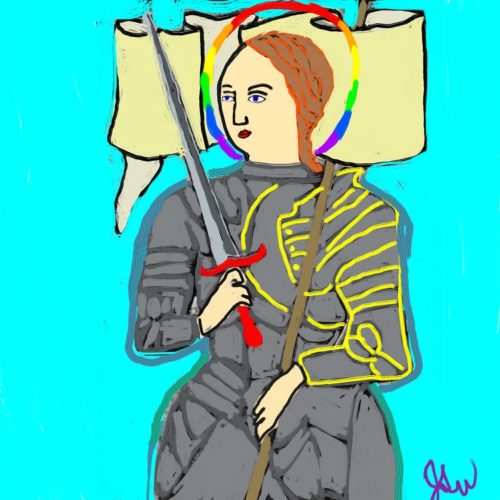
Joan of Arc was a tough cross-dressing teenage peasant warrior who led the medieval French army to victory at age 17. Joan is a queer icon, girl-power hero and patron saint of France. Her belief that God was the source of her — or their or his — gender-bending queerness makes Joan especially inspiring for LGBTQ people of faith. Her feast day is May 30, a suitable saintly lead-in to Pride Month.
Smart and courageous, Joan of Arc (c. 1412-1431) had visions of saints and angels who told her to cut her hair, put on men’s clothes and go to war. She led armies numbering in the thousands and turned the tide in the Hundred Years War. At age 18 she helped crown a king and at 19 she was killed by the church that later made her a saint. She died for her God-given right to wear clothing that did not match her sex assigned at birth, the “heresy” for which she was executed on May 30, 1431.
Joan of Arc is one of the most popular saints at Q Spirit — and in mainstream society worldwide. She is also Q Spirit’s top female saint, although Joan is increasingly seen as a nonbinary person or transgender man. Joan’s extraordinary life continues to fascinate all kinds of people. She remains one of the best-known female saints, right up there with Mary, the mother of Jesus — and certainly a contrast to her. While icons show the Madonna cradling her baby, Joan is often pictured carrying a sword. She is the the only female saint who appears as a warrior in armor. Like many contemporary LGBTQ people, Joan was abused by her own church. Her persecution by religious and political leaders feels familiar to LGBTQ people of faith, but Joan is the only official saint who was both canonized and condemned to execution by the church. As social and religious outcasts, LGBTQ people may relate to her experience of being betrayed by the church and the king whom she put on the throne.
Joan infiltrated the old boys’ club of the most venerated saints, which had been male-dominated until she arrived in her suit of armor. Many groups are eager to claim her as a symbol, from LGBTQ people and feminists to the Catholic Church and French nationalists. Joan is the subject of more than 10,000 books, plays, paintings and films. This article features contemporary LGBTQ portraits of Joan, plus many historical images.
LGBTQ people today recognize a kindred spirit and role model in her stubborn defiance of gender rules. Queer writers tend to downplay Joan’s Christian faith, while the church covers up the importance of her cross-dressing. In truth, Joan believed strongly in God AND in cross-dressing. Joan resonates with readers today because her individual beliefs put her at odds with the church. She insisted that God wanted her to wear men’s clothes, making her what today can be called queer, lesbian, nonbinary, transgender or intersex. It’s hard to apply these contemporary categories to people who lived centuries before those terms existed, and both the lesbian and trans communities are inspired by Joan and claim her as one of their own. Joan is also queer simply because she had mystical experiences, which by definition are odd and dangerous because they are not controlled by religious authorities and sometimes contradict them.
There are similarities between Joan and the medieval archetype sometimes known as the trans saint or “holy transvestite,” people who were assigned female at birth and assumed male identities to live as monks and hermits. Cross-dressing was illegal, but what really upset the church authorities, then as now, was the audacity of someone being both proudly queer AND devoutly Christian.
“I was admonished to adopt feminine clothes; I refused, and still refuse. As for other avocations of women, there are plenty of other women to perform them,” she said.
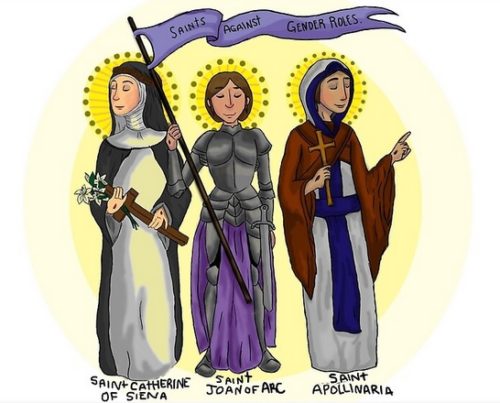
Apollinaria, right, carries a banner proclaiming, “Saints Against Gender Roles,” along with Catherine of Siena and Joan of Arc in an image that is available on many products from Stargirllily at Redbubble.
The extensive records of her trials by the Inquisition make Joan of Arc the best-documented person of 15th century. There are only hints that she may have acted on lesbian attractions, but the evidence is absolutely clear about her cross-dressing — which can be interpreted as an expression of transgender, nonbinary or butch lesbian identity or a chaste cis-gender heterosexual woman disguising herself to remain safe. On March 25 of her trial, Joan said that “it is not in her” to wear women’s clothes and that that men’s clothes “did not burden her soul.”
New in 2025: Two LGBTQ books feature Joan of Arc
Joan of Arc is featured in two new LGBTQ books in 2025.
At least a dozen queer saints, including Joan of Arc, show up to help a gay Catholic teen unite his faith and sexuality in the 2025 graphic novel Hey, Mary!” by Andrew Wheeler (author) and Rye Hickman (illustrator).

Genderqueer Joan of Arc advises a gay teen in “Hey, Mary!” by Andrew Wheeler (author) and Rye Hickman (illustrator).
The book portrays Joan as a self-proclaimed “genderqueer warrior saint” who drops French phrases between words of wisdom such as: “Queer and gay and trans… These are modern words, but the identities they represent have ALWAYS been with us. Even among the saints.” Raised Catholic, Wheeler is a Toronto–based author from England and Rye Hickman is a Denver-based visual storyteller who grew up evangelical and graduated from the Savannah College of Art and Design’s sequential art program. Published by Oni Press and distributed by Simon and Schuster.
“Queer Devotion: Spirituality Beyond the Binary in Myth, Story, and Practice” by Charlie Claire Burgess includes a chapter called “The Queer Devotion of Joan of Arc.” A liberating exploration of the queer divine in myth and history, the book offers ways for LGBTQ people to cultivate the divine within. Each chapter ends with suggestions for devotional exercises and questions for contemplation. The author is a queer and non-binary tarot reader, teacher, illustrator, podcaster and writer based in Portland, Oregon. Published by Hay House.
Joan of Arc’s life story
Joan of Arc, also known as Jeanne d’Arc, was born to peasants in Domremy, an obscure village in eastern France around 1412, toward the end of the Hundred Years War. Much of France was occupied by England, so that Charles, the heir to the French throne, did not dare to be crowned. When Joan was 13, she began experiencing visions and hearing voices that told her to help France drive out the English.
The visions continued for years, becoming more detailed and frequent. Once or twice a week she had visions of Michael the Archangel and two virgin saints: Catherine of Alexandria and Margaret of Antioch (another potentially trans saint who refused to marry a man). They told her that God wanted her to meet Charles and lead an army to Reims for his coronation.

Joan of Arc’s life story is told in in the illustrated book “Heavenly Homos, Etc.: Queer Icons from LGBTQ Life, Religion, and History” by Jan Haen, a Dutch artist and Roman Catholic priest.
Joan’s family tried to convince her that her visions weren’t real, and her first attempt to visit the royal court was rejected. When she was 17 she put on male clothing and succeeded in meeting Charles. She was about five-foot-two in height, with a muscular build. Charles agreed to outfit her as a knight and allowed her to lead a 5,000-man army against the English.
Then as now her faith was inspirational. “It is better to be alone with God. His friendship will not fail me, nor His counsel, nor His love. In His strength, I will dare and dare and dare until I die,” she proclaimed.

“Saint Joan of Arc” by Brother Robert Lentz. Prints available at Amazon and Trinity Stores.
On Charles’ order, a full suit of armor was created to fit Joan. He had a banner made for her and assigned an entourage to help her: a squire, a page, two heralds, a chaplain and other servants. She led an army whose size fluctuated from a few hundred up to about 4,000 strong.
 |
| Joan of Arc on Horseback, 1505 Wikimedia Commons |
Joan’s appearance awed the soldiers and peasants when she traveled with the army. Mounted on a fine warhorse, she rode past cheering crowds in a suit of armor. Her hair was “cropped short and round in the fashion of young men.” She carried an ancient sword in one hand and her banner in the other. Her sword was found, as Joan predicted, buried at the church of St. Catherine at Fierbois. The banner showed Christ sitting on a rainbow against a background of white with gold lilies and the motto “Jhesus-Maria.” Legend says that white butterflies followed Joan wherever she rode with her banner unfurled.
With Joan leading the way, the army won the Siege of Orleans and continued to defeat English and pro-English troops until they reached Reims. She proudly stood beside Charles VII at his coronation there on July 17, 1429.
Joan soon resumed leading military campaigns. Even during her lifetime the peasants adored her as a saint, flocking around her to touch her body or clothing. Her cross-dressing didn’t disturb them. In fact, they seemed to honor her for cross dressing. Perhaps, as some scholars say, the peasants saw Joan as part of a tradition that linked transvestites and priests in pre-modern Europe.
Capture and trial of Joan of Arc
Joan’s illustrious military career ended in May 1430. She was captured in battle by the Burgundians, the French allies of the English. During her captivity they called her “hommase,” a slur meaning “man-woman” or “masculine woman.”
In a stunning betrayal, Charles VII did nothing to rescue the warrior who helped win him the crown. It was normal to pay ransom for the release of knights and nobles caught in battle, but he abandoned Joan to her fate. Historians speculate that French aristocrats felt threatened by the peasant girl with such uncanny power to move the masses.
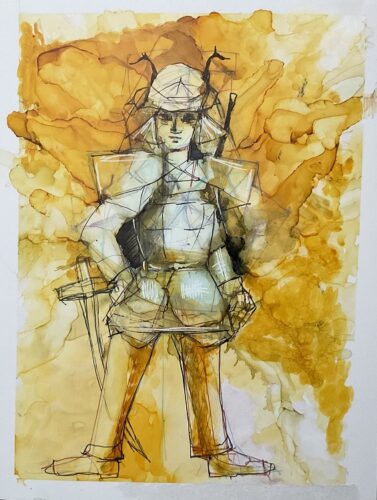
Joan of Arc by New Mexico artist Harriet Anaya
The Burgundians transferred Joan to the English, who then gave her to the Inquisition. She spent four torturous months in prison before her church trial began on Jan. 9, 1431 in Rouen, the seat of the English occupation government. She was charged with witchcraft and heresy.
The politically motivated church trial was rigged against her, and yet Joan was able to display her full intelligence as she answered the Inquisitors’ questions. Her subtle, witty answers and detailed memory even forced them to stop holding the trial in public.
Witchcraft was hard to prove, so the church dropped the charge. (Many of today’s Wiccans and pagans still honor Joan as one of their own.) The Inquisitors began to focus exclusively on the “heresy” of Joan’s claim that she was following God’s will when she dressed as a man. The judges told her that cross-dressing was “an abomination before God” according to church law and the Bible. (See Deuteronomy 22:5.)
Convicted of cross-dressing
They accused Joan of “leaving off the dress and clothing of the feminine sex, a thing contrary to divine law and abominable before God, and forbidden by all laws” and instead dressing in “clothing and armor such as is worn by man.”
Joan swore that God wanted her to wear men’s clothing. “For nothing in the world will I swear not to arm myself and put on a man’s dress; I must obey the orders of Our Lord,” she testified. She outraged the judges by continuing to appear in court wearing what they called “difformitate habitus” (“monstrous dress” or “degenerate apparel.”)
Today Joan’s conservative admirers claim that she wore men’s clothes only as way to avoid rape, but she said that it meant much more to her. Joan of Arc saw cross-dressing as a sacred duty.
The judges summarized Joan’s testimony by saying, “You have said that, by God’s command, you have continually worn man’s dress, wearing the short robe, doublet, and hose attached by points; that you have also worn your hair short, cut ‘en rond’ above your ears with nothing left that could show you to be a woman; and that on many occasions you received the Body of our Lord dressed in this fashion, although you have been frequently admonished to leave it off, which you have refused to do, saying that you would rather die than leave it off, save by God’s command.”
Joan refused to back down on the visions she received from God, and she was sentenced to death. She was burned at the stake on May 30, 1431 in Rouen. Twenty five years later she was retried and her conviction was overturned. Joan was declared innocent.
Her armor, that “monstrous dress,” became an object of veneration, sought after like the Holy Grail with various churches claiming to possess her true armor. Joan of Arc was canonized as a saint in 1920.
Was Joan of Arc a lesbian?
Even if she made a vow of celibacy, Joan of Arc could have been a lesbian orientation based on the American Psychological Association definition of sexual orientation as “an enduring pattern of emotional, romantic, and/or sexual attractions.” There is speculation that she was an intersex person with androgen insensitivity syndrome.
Lesbian playwright Carolyn Gage’s one-woman show “The Second Coming of Joan of Arc” is an underground classic with Joan as “a cross-dressing, teenaged, runaway lesbian” confronting male-dominated institutions. In 2008 it won the Lambda Literary Award, the top US LGBTQ book award, in the drama category.
One of the first modern writers to raise the possibility of Joan’s lesbianism was English author Vita Sackville-West. She implied that Joan was a lesbian in her 1936 biography “Saint Joan of Arc.” The primary source for this idea was the fact, documented in her trials, that Joan shared her bed with other girls and young women. She followed the medieval custom of lodging each night in a local home. Joan always slept with the hostess or the girls of the household instead of with the men.
“Joan of Arc: Her Trial Transcripts” by Emilia Philomena Sanguinetti is a 2016 book that explores whether Joan was a lesbian or transgender person. Extensive evidence that Joan of Arc was a lesbian or transgender person is presented in the epilogue of this groundbreaking book about the cross-dressing medieval saint. She explores how Joan shared her bed with another woman and insisted on wearing male clothing.
Nobody knows for sure whether Joan of Arc was sexually attracted to women or had lesbian encounters, but her abstinence from sex with men is well documented. Her physical virginity was confirmed by official examinations at least twice during her lifetime. Joan herself liked to be called La Pucelle, French for “the Maid,” a nickname that emphasized her virginity. Witnesses at her trial testified that Joan was chaste rather than sexually active. Some contemporary feminists believe that “virgin” did not mean sexless, but belonging to no man. There are many “virgin saints” who refused heterosexual marriage and joined convents to have their primary relationships with women. They become role models for lesbians of faith.
Joan of Arc in the arts
Joan of Arc has a halo with the rainbow colors of the LGBTQ community in a 2022 icon by North Carolina artist Jeremy Whitner. It appears at the top of this post. She wears full armor and carries a sword. The image is based on a miniature of Joan that was painted between 1450 and 1500, which was only a few decades after her death.
Whitner is a queer Christian iconographer in process for ministry with the Disciples of Christ. He attends Union Presbyterian Seminary in Charlotte, North Carolina. His icons appear frequently on Q Spirt. Prints of his icons are available at Whitner’s Fine Art America shop.
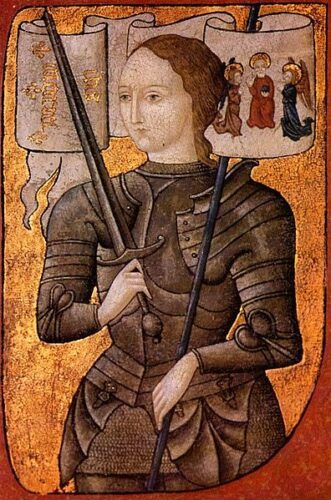
Joan of Arc miniature, 1485 (Wikipedia)
An androgynous Joan of Arc has a bound chest and a rainbow halo in an icon by queer Lutheran artist and seminarian Katy (Keats) Miles-Wallace in 2017 as part of her “Queer Saints” series. Her icon of Joan is modeled after genderqueer model Rain Dove. The series presents traditional saints with queer qualities and heroes of the LGBTQ community.
The icons are rooted in queer theology and in Miles-Wallace’s eclectic faith journey that began at a Baptist church in Texas and led to study at Pacific Lutheran Theological Seminary in Berkeley, California. She drew many of them on the altar of a seminary chapel. For more info, see the Q Spirit article “New icons of Queer Saints created by artist Katy Miles-Wallace.”
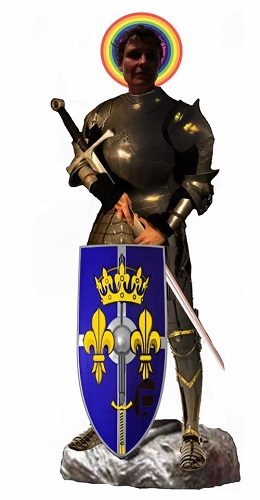
Saint Joan of Arc from “Triptych for the 49” by Tony O’Connell
Joan of Arc also has a rainbow halo in “Triptych for the 49” by gay artist Tony O’Connell of Liverpool. Joan of Arc and Sebastian appear as “wrathful protector saints” in the artwork, which honors those killed in the 2016 mass shooting at the Pulse gay bar in Orlando, Florida.
Lewgalon is a spiritual artist based in Germany and also a cleric in the Old Catholic Apostolic Church. Lentz is a Franciscan friar known for his innovative and LGBTQ-positive icons. He is stationed at Holy Name College in Silver Spring, Maryland.
“Jeanne d’Arc” was sketched by Tobias Haller, an iconographer, author, composer, and retired vicar of Saint James Episcopal Church in the Bronx, still assisting at a parish in Baltimore, Maryland. He is the author of “Reasonable and Holy: Engaging Same-Sexuality.” Haller enjoys expanding the diversity of icons available by creating icons of LGBTQ people and other progressive holy figures as well as traditional saints. He and his husband were united in a church wedding more than 30 years ago and a civil ceremony after same-sex marriage became legal in New York.
A disturbing art installation emphasizes the connection between Joan’s execution and anti-trans violence that is fueled by Christian nationalism today. “In Memoriam / Distress Signal” by Joseph Liatela, an interdisciplinary artist based in New York City, was exhibited at the Yeh Art Gallery in 2022. An enormous burnt stake stood at the center of the installation to represent Joan. It was surrounded by glasses of ocean water that equaled the number of trans people murdered in the United States so far that year.
A portrait of Joan kissing her sword was painted by Pre-Raphaelite artist Dante Gabriel Rossetti, whose sister Christina Rossetti is also part of the LGBTQ Saints series at the Jesus in Love Blog at Q Spirit.
Joan has a dialogue with the fire that is about to consume her in a haunting song written by award-winning Canandian poet Leonard Cohen and sung on July Collins video.
Generations of movie audiences have learned the saint’s story from the 1948 Academy Award-winning historical drama “Joan of Arc” starring Ingrid Bergman.
Nonbinary Joan of Arc stars in play “I, Joan”
A recent high-profile LGBTQ interpretation of the martyr’s life is “I, Joan,” a play about a nonbinary Joan of Arc that premiered in August 2022 at Shakespeare’s Globe theater in London. Written by nonbinary playwright Charlie Josephine, it begins boldly with nonbinary actor Isobel Thom as Joan declaring, “Trans people are sacred.” A video trailer shows lively scenes from the production.
Times have changed since 2008, when a play about a lesbian Joan of Arc was getting awards and attention: “The Second Coming of Joan of Arc” by Carolyn Gage. News media coverage of “I, Joan” revealed the growing tension as feminist and transgender communities are vying to appropriate the saint for their own cause.
News media coverage of “I, Joan” revealed tensions within the LGBTQ coalition as feminist and transgender communities each asserted the right to define the saint. “The feminist argument against ‘I, Joan’’s gender politics is that nonbinary identities are an act of individual liberation that pushes the rest of us back into rigid pink and blue boxes,” explains an analysis at the Atlantic.
Authors look at the queer Joan of Arc
Famous writers and composers who have done works about Joan of Arc include Shakespeare, Voltaire, Verdi, Tchaikovsky, Mark Twain, Bertolt Brecht and George Bernard Shaw. Transgender author Leslie Feinberg has a chapter on Joan as “a brilliant transgender peasant teenager leading an army of laborers into battle” in her history book “Transgender Warriors: Making History from Joan of Arc to Dennis Rodman.” And Joan is included in the 2017 LGBTQ history book for teens, “Queer, There, and Everywhere: 23 People Who Changed the World” by Sarah Prager.
Joan of Arc Prayer
Q Spirit’s Litany of Queer Saints includes this line:
Saint Joan of Arc, courageous queer warrior who defied gender norms, burned as a heretic yet canonized as a saint, pray for us.
A widely used prayer to Saint Joan of Arc makes a powerful statement that can inspire those who believe in equality for LGBTQ people, despite rejection by religion and society:
“In the face of your enemies,
in the face of harassment, ridicule, and doubt,
you held firm in your faith.
Even in your abandonment,
alone and without friends,
you held firm in your faith.
Even as you faced your own mortality,
you held firm in your faith.
I pray that I may be as bold
in my beliefs as you, St. Joan.
I ask that you ride alongside me
in my own battles.
Help me be mindful
that what is worthwhile
can be won when I persist.
Help me hold firm in my faith.
Help me believe in my ability
to act well and wisely. Amen.”
Links related to Joan of Arc
Wikipedia article on Cross-dressing, sexuality, and gender identity of Joan of Arc
“Controversial Saints: Joan of Arc” animated digital painting by Alexandria Babineaux (Explorations: the Texas A&M Undergraduate Journal, 2022)
Joan of Arc trial transcript online
The Patron Saint of Dysphoria: Joan of Arc as Transgender (thingstransform.com)
Joan of Arc: Cross-dressing martyr at Queering the Church Blog
Joan of Arc sculpture by Anna Hyatt Huntington at the Cathedral of Saint John the Divine in New York City
Translations on Joan of Arc as a queer icon
To read this article in Spanish / en español, go to Santos Queer:
Juana de Arco: Santa Travesti
To read this article in Italian, go to Gionta.org:
Una guerriera genderbender. La favolosa vita di Giovanna d’Arco
To read this article in Persian, go to:
سنت ژاند شخصیتی در سرپیچی از قواعد جنسیتی می (anastasius_sacredheart on Instagram)
To read a French interview about Joan of Arc with Q Spirit founder Kittredge Cherry, go to Komitid.fr:
Marine Le Pen s’est trompée, Jeanne d’Arc est en fait une icône queer
(Marine Le Pen was wrong, Joan of Arc is actually a queer icon)
Prière au Christ Arc-en-Ciel: le drapeau LGBT révèle le Christ queer (Rainbow Christ Prayer in French)
___
Top image credit:
“Joan of Arc” by Jeremy Whitner.
___
This post is part of the LGBTQ Saints series by Kittredge Cherry. Traditional and alternative saints, people in the Bible, LGBTQ martyrs, authors, theologians, religious leaders, artists, deities and other figures of special interest to lesbian, gay, bisexual and transgender and queer (LGBTQ) people and our allies are covered.
This article has evolved and expanded greatly since the first version was posted in May 2011. It was published on Q Spirit in May 2017, was enhanced with new material over time, and was most recently updated on May 31, 2025.
Copyright © Kittredge Cherry. All rights reserved.
Qspirit.net presents the Jesus in Love Blog on LGBTQ spirituality.

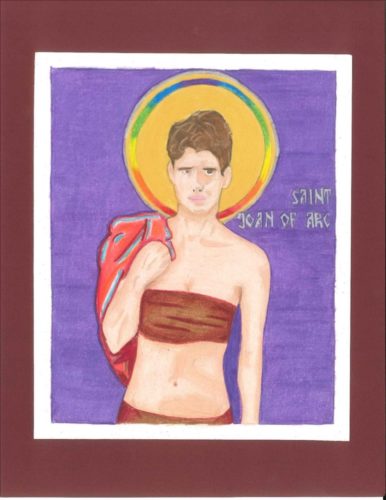

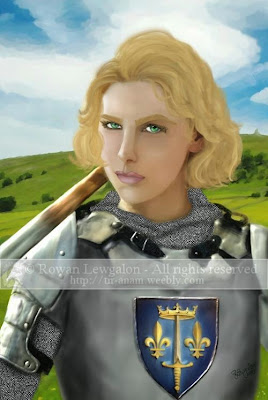



















Saint Joan of Arc was a devout Catholic woman, not a lesbian or transgender or non-binary. Saint Joan of Arc is most definitely somebody I can look up to as a teenage Catholic girl, and she deserves to be recognised for her bravery and commitment to God. She shouldn’t be commemorated as some ‘lesbian icon’ or girl boss. Please have some respect for Christianity and its saints, as they have lived holy lives and literally given up their lives to God, just for you to come along and turn it into some sort of joke.
In the bible it states in Leviticus 18-22 “ Do not have sexual relations with a man as one does with a woman; that is detestable.”. The same goes for women having relations with other women. It is not natural. There are many other verses in the bible that support this, that is, if you’ve ever picked up a bible.
I’m just shocked that the LGBT community thinks they have the right to twist Joan of Arc into something she is not (and never will be). And how do you consider yourself a christian when you practice homosexuality? That’s totally beyond me, and it goes against Christian values.
Also, what the hell are those drawings of Joan of Arc? Before you go and draw her half naked with rainbow halos, please try and consider the people who might see it; for example a teenage girl that now can’t look at Joan of Arc the same ever since the LGBT community has claimed she’s a lesbian. Leave my religion alone, and leave our saints alone.
Very well said! It is both surprising and appalling how ignorant many are about the life of St. Joan of Arc. As was presented in a biography of her, the author’s contention was that St. Joan cut her hair short and wore men’s clothing to protect her sexual purity and avoid being sexually assaulted since she was surrounded by men.
To infer or claim that St. Joan was “queer” is a projection of today’s norms on a more primitive but religiously devout age. It is an both an injustice to Joan and all those who were privileged to know her!
You added some new material (mostly about the “I, Joan” play) while still giving a badly misleading description of the related “male clothing” issue which “I, Joan” also distorted in much the same manner. Read what so many historians have said about the issue: two of the soldiers who escorted Joan of Arc to Chinon (Jehan de Metz and Bertrand de Poulengy) described how they were the ones who brought up the idea of giving her a soldier’s horseback riding outfit to wear for obvious reasons (a dress doesn’t protect the inside of the thighs from constant abrasion against the horse’s flanks, so they gave her long hip-boots, trousers, and a tunic to which the boots and trousers were attached with laces, which she later used both in camp and especially in prison to protect herself from rape by keeping the parts of the outfit all laced up securely, according to numerous eyewitness accounts). This doesn’t make her “queer” unless every woman who has ever worn practical clothing is also “queer”; and the medieval Church’s official doctrinal summaries explicitly state that practical necessity was a permissible exemption from the normal rule against cross-dressing, which was only condemned if it was done for sinful reasons, not if done out of necessity (see the “Summa Theologica”, “Rosarium super Decreto” and other official sources from that era). The trial transcript’s version of her alleged motives was debunked by the many eyewitnesses who said the transcript was falsified on that point, which means you cannot use the transcript’s claims while ignoring everything else. It is also dishonest to claim that the “Church” opposed her since she had already been given the approval of a group of high-ranking clergy at Poitiers in April 1429 (Charles VII had her examined by clergy before letting her accompany an army), including the Inquisitor for Southern France (Pierre Turelure) and many others. The trial was conducted by people who are listed in English government records as collaborators who supported the English cause, and the judge (Pierre Cauchon) additionally had a long and well-documented history of corruption as well as a criminal conviction in 1414. She was supported by numerous other clergy during her lifetime (the Archbishop of Embrun, Inquisitor Jehan Dupuy, the famous theologian Jehan Gerson, and many others who wrote treatises or letters supporting her during her military campaigns). The “I, Joan” play also makes the mistake of misinterpreting all of these issues while additionally making the absurd claim that she never identified as a girl despite the patent fact that she constantly called herself “the maiden” (“la pucelle”) to link herself to a prophecy about a “maiden from the borders of Lorraine” who was predicted to save France, which she often cited to convince people to support her. This was her main theme and hence a large part of her public identity, and it conclusively shows that she identified as a girl since that’s what a “maiden” is and that was the entire point of the prophecy. On the lesbian issue: you still cite Sanguinetti’s book even though it’s filled with nonsense : e.g. describing visions from St. Catherine and St. Margaret does not mean Joan was having sex with two physical women as Sanguinetti claims, and Marguerite la Thouroulde never described doing anything with Joan in a private “bathtub” as Sanguinetti thinks: instead, she merely described the routine practice of going to the public “bathing” areas where women would wear dresses for modesty’s sake while washing their arms and shoulders etc, which has nothing to do with lesbian sex and it was the norm for anyone who lived in a town that offered public facilities with heated water for such purposes. Please make the article more honest about these issues.
Kittrage Cherry, you are perverting and distorting St. Joan’s life so you can find some illusionistic attachment to a holy person, which would in turn help you to validate your own self worth. Stop spreading this false information. You are no where near the truth here.
Its articles like this that showcase one person’s modern day opinion as possible facts. Please stop. If anyone has ever studied St. Joan of Arc, really studied her life in a historical, theological, and cultural sense, they would come to the conclusion that this information is not only a completely incorrect portrayal of the 19 year old maiden, but also derogatory.
St. Joan was called by God to save France, guided by Sts. Catherine & Margaret and St. Michael the Archangel. She spent hours a day in prayer, went to mass as often as she could, if not daily, in need of Christ via the Eucharist. She refused to take her men into battle if they had not gone to confession first. Those close to her called her “saintly”, “obedient”, “virtuous”, “a good and holy girl.” She spent hours on her knees praying to the Blessed Mother. She slept with her clothes extra tied around her so as to prevent being raped by her captors. She was not killed by the church, she was executed by the English who were afraid of her, rightly so. Let me make it clear, she did not die for the right to wear men’s clothing and have a men’s haircut. Good grief! She died for Jesus.
You found one quote that could support your argument here and perverted it as well. It is taken out of context. The full quote is, “It is true that at Arras and Beaurevoir I was admonished to adopt feminine clothes; I refused, and still refuse. As for other avocations of women, there are plenty of other women to perform them,” she said. Joan was captured and held by the English at Arras and Beaurevoir. In addition, God told St. Joan to wear the warrior/men’s clothing. Above all, St. Joan wanted to please the Lord.
She is not a “feminist” according to the modern day definition you claim to be feminism. However, she is definitely a feminine genius (thank you St. PJP II) one whom we should look up to for strength in trials where we seek out God’s help.
St. Joan had no fear because anything is possible for God.
Many females throughout history dressed and even lived as men, not because they were queer but out of necessity. They could not do what, in many cases they felt God called them to do, within the confines of gender expectations at the time. They still identified as female (they didn’t say they felt they were men) – which is why Joan of Arc boarded with other girls where she stayed.
The tendency of some today to queerify historical figures and define them according to their standards does injustice to these great women who proved females could (and can) do what they set out to do regardless of social restrictions and stereotypes. It implies they couldn’t possibly be as they were if they were cis female, thus perpetuating gender stereotypes. This is antifeminist.
I really appreciate this article. I actually own the book by E.P. Sanguetti which discusses evidence of Joan’s sexuality and gender identity. I’d suggest adding a few more lines to the article from her trial transcripts, such as the fact that Joan said of wearing women’s clothes that “it is not in her to do it” (March 25th) or that when arguing about which clothes she should be allowed to wear to Mass for about the billionth time she claimed that men’s clothes “did not burden her soul.”
These quotes, I believe, more explicitly demonstrate that Joan experienced gender dysphoria in addition to her wanting to avoid rape. It is not as though being a transgender person immediately protects a person from being raped. Nor does the fact that she was trying to avoid rape immediately invalidate any evidence that she was transgender. And yet, people act as though it is.
I’ve also heard of another book by Clovis Millet, called “Les genres fluides” which discusses Joan’s gender identity. I have not read it because I do not speak French, but if anyone knows where I can get an English translation, I’d love to get my hands on it!
Here is a review of it (in French):https://www.youtube.com/watch?v=grc1KQEaKHA
It is very odd, I have seen over and over again some people, who describe themselves to be feminist, act as though Joan of Arc was the only person assigned female at birth to do anything note-worthy in all of history, and so act as though their only female role model has been lost forever when a person merely suggests that Joan may have been uncomfortable identifying as a woman. I can tell you right now, there are hundreds of thousands of women throughout history who have accomplished amazing things. But statistically speaking, it is inevitable that some of those people who were labeled ‘women’ in their time would have felt more comfortable identifying as a man if they’d been given the freedom to do so. I think that Joan of Arc may have been transgender because of words that came from her own mouth, not because I believe that only men can lead armies, or be strong, independent people. I think it is best to respond to the argument that those who claim Joan as a trans icon believe that women cannot turn around wars, be highly intelligent, or otherwise do things that are worth honoring and studying with a quote from Joan herself: “There are enough other women to do them.”
There seems to be a sort of unnecessary conflict between transgender people and some feminists. Last summer, there was the whole thing with J.K. Rowling, and I even heard of some people claiming that Elliot Page was ‘abandoning lesbians’ after coming out as trans. Perhaps because women have been so long oppressed and under-represented in historical curricula, it does feel like a much more significant loss when a feminist icon turns out to not be a woman than it would feel to men if a man from history turned out to not be a man. I am no expert, however, I highly doubt that transgender people are more or as often represented in history as women or men.
I know that historically speaking (in the U.S., at least) lesbians and trans women have long been excluded by the feminist movement. When it comes to more recent decades, however, I don’t know much about how LGBT+ people have been involved in the feminist movement and how they were received. I am actually putting together a presentation with a friend about the entwined nature of advocacy women’s rights and for LGBT+ rights, so if anyone has any good articles or books to recommend, I could definitely use them!
Re: the idea that Joan of Arc was uncomfortable identifying as a woman: she repeatedly called herself “the maiden” (“la pucelle”) as her chosen moniker (which is mentioned even in the transcript and even more so in the many other sources), to the point that it became her standard designation in many of the 15th century sources; which proves she wasn’t uncomfortable identifying as a woman. Numerous eyewitnesses said she had worn a dress up until the soldiers who escorted her to Chinon gave her a soldiers’ outfit for practical reasons, and there are 15th century accounts which say she went back to a dress whenever possible up until her imprisonment with abusive English guards led her to wear the soldiers’ outfit because, according to several eyewitnesses, she said she was using this outfit’s cords that could be laced through eyelets to attach the different parts together so her guards couldn’t pull her clothing off when they tried to rape her on occasion. This is why it protected her against rape, and the motive of protection is established by her own statements relayed by eyewitnesses. The comments attributed to her in the trial transcript on this issue are extremely vague and certainly far too ambiguous to contradict her clear statements mentioned above, and many eyewitnesses said the transcript was falsified on important points (which calls its accuracy into question). All of this has been pointed out by many historians.
Thank you for pointing out the best quotes from Joan at her trial. I was able to verify them from her online trial transcript, so I added them to my main article today.
Almost every issue raised in this article has been debunked by historians. The English government’s internal records admit that they selected the tribunal members – all of whom are well-documented to have been pro-English – and many of the tribunal members later admitted that the charges were false and the transcript was falsified on crucial points including her alleged reasons for “cross-dressing”. Several eyewitnesses said she explained the practical reason why she continued wearing soldiers’ clothing in prison (the “cross-dressing” issue) : it was because this type of clothing had cords that could be laced through eyelets to attach the different parts together so her guards couldn’t pull her clothing off when they tried to rape her on occasion, which has nothing to do with transgenderism. Sanguinetti’s claims about Joan’s alleged lesbianism merely come down to the idea that her description of taking a vow of virginity “really” means that she pledged to have lesbian sex with two physical women, which is surely one of the silliest attempts to make her into a lesbian (no, there’s nothing “groundbreaking” there). The Royal records also show that she didn’t “lead” the army since the full command structure is given in the military records; and she herself said at her trial (during the fourth session) that her role was carrying her banner rather than leading or fighting.
Kitt,
thank you for your great research!
Joan was the ‘wonder woman’ of her time, valiant enough to go with the guidance of personal visions in her faith, as well as still being a chosen one of God to perform this specific duty.
She was, as in her duty, to become a transgender man in appearance, to take up her mantle and win this battle.
Instead of being seen by Church and state as a brave/religious soul, they took it upon themselves to make an example of her sexuality, something that she remained a true virgin (imagine the embarrassment that was, being examined), and use the Bible against her for her cutting of her hair and wearing of male clothing.
As a Trangender female myself, I see her as a brave soul in a time of age where we are being looked at as outcast; I hope no day comes where we too, will all be led out to burn at the stake because of who we are.
God worked with Job, Jonah, and many others who suffered greatly for their faith. This woman became a martyr for her faith.
God help us, you can wrap me in a transgender flag and tie me to the stake if you wish, I cannot change what i am.
to think that joan died a virgin is pretty naive, i think
Any notable woman at this point will be revised into being trans….this is sexist! The whole sexist narrative that women never do anything to change the world so now…you are going to make her not a woman. How rude!!!
Women need people to look up to and for anyone on here saying oh it’s so lonely being a gay Catholic!!….this isn’t about you as a man. This is about women being erased. This is horrible and you should take it down immediately!
Cecilia, you accuse me of erasing Joan’s female identity — and then you call me a man! I am a lesbian woman. This is clear if you read my bio at the end of my article. FYI, I have been considered female since birth (“cisgender.”)
I have long considered Joan of Arc to be a lesbian role model for me, but in this article I am trying to be historically accurate. It’s hard to apply contemporary categories such as “lesbian” or “transgender” to people who lived centuries before those terms existed. I intend to raise both possibilities in this article.
I will change a few words of this article in an effort to make that clearer.
Cecilia, I think the transgender person above was not trying to say that Joan was born a male and then transgendered to female before accomplishing her famous exploits. Joan was most certainly born a female, a woman, and was a virgin. She was examined by noble ladies twice (at Poitiers before being given a suit of armor and put at the head of the relief army sent to Orleans, which was besieged by the English, at the end of April, 1429) and during her rigged mock condemnation trial in Rouen in 1431, at which an English noble woman (the Duchess of Bedford, the Duke oF Bedford’s wife) also determined that Joan was indeed a woman and a virgin, so the English could not charge her with witchcraft (a witch had supposedly slept with the devil). So you are perfectly correct, Joan was indeed a woman and one of the most famous that ever lived. Winston Churchill said this of Joan of Arc, “She was so far above the ordinary run of mankind that her like won’t be seen again for a thousand years.”
Joan raised the siege at Orleans at age 17 and was executed at age 19 on May 30, 1431. The English feared and hated Joan because she had defeated them sounded in battle several times. At her trial they tried to trick her with the question, “Are you in God’s Grace?” If she said yes she was guilty of being a heretic because nobody knows if they’re in God’s grace. If Joan said no, then she was certainly guilty of something. Joan’s famous answer was, “If I am not in God’s grace, may He put me there. If I am in His grace, may he so keep me.” Her inquisitors were stunned by this answer.
So the religious right are correct and trans people are confused cross-dressers and not the gender they identify.
In this article I tried to leave open the possibilities that Joan of Arc may have been transgender, intersex, lesbian, and/or other options. She’s a historical figure so it’s hard to fit her into today’s categories. It doesn’t mean that I agree with the religious right about today’s trans people, because I don’t.
St. Joan of Arc was a young, pious Catholic woman. She was executed at the age of 19 because of political intrigue. Church authorities in northern France were loyal to the British Crown and wanted to win their favor. They captured St. Joan and transported her to their ecclesiastical jurisdiction for a trial. They made several accusations in an attempt to entrap her in heresy which was a crime punishable by death. “Crossdressing” was one of the accusations. In the midst of educated theologians, the illiterate St. Joan defended herself well but the decision against her was pre-planned and pre-ordained. It was a “kangaroo trial.” Their is no good evidence to say that she was a lesbian. Instead, most likely, she made a promise of celibacy to God which is common of those committed to the Lord. Perhaps she would have eventually entered a convent and become a nun. For those with little or no faith this choice is difficult to believe. For those of sufficient or deep faith her actions are readily understandable. The most obvious reason for her virginity/celibacy is likely the correct answer. She deserves the dignity to be accepted at her word instead of reading it through the lens of 21st century public more’s. May she intercede before God for all men and women who have chosen to dedicate themselves to Him in a life of chaste and celibate service to God and her fellow man!
Joan of Arc could have made a vow of celibacy while while having a lesbian orientation based on the American Psychological Association definition of sexual orientation as “an enduring pattern of emotional, romantic, and/or sexual attractions.”
What a ridiculous statement: the sacred duty she refers to is not the fact of wearing the clothes itself but France freedom. In this case the clothes are a tool, much more when she marched to battle. Anybody understands that. And despite the excuse of the authorities, they killed her because of political interests.
You are correct Roy. Joan was executed because she raised the siege of Orleans in May, 1429, and then soundly defeated them at the Battle of Patay in June, 1429. She was then able to conduct the Dauphin to Rheims to be crowned King Charles VII of France in July. The English, of course, were furious at Joan because they wanted their King, Henry VI, to be crowned King of France. So when they “bought” Joan from their allies, the Burgundians, for 10,000 livres, they took her to Rouen to stand trial for heresy and witchcraft.
It is very unlikely that Joan of Arc was a lesbian. Not just because she was very devout and devoted to God, but she detested prostitutes, camp followers, who she drove out of camp rather than cause her soldiers to “sin”. These women could only stay if they married their lovers. Joan actually broke her sword in half once when she smacked a woman on the butt from her horse with the flat of her sword while chasing her out of camp. No, Joan was no lesbian.
Mary Kennedy, in her short biography of St. Joan of Arc, asserts that her manner of dress and hairstyle was employed for a very practical reason: to preserve her chastity and prevent her from being raped. Remember, she was the lone woman amongst hundreds or thousands of men and would be a tempting target to rape. Kennedy’s book details one or two near incidences of it. The “Church” per se was not the one who put St. Joan to death. Rather, it was English religious and political factions vying for that honor. Instead of speculating on St. Joan’s sexuality it might be better to focus instead on her deep Christian mysticism.
Thank you for this beautiful article. I keep a few images around my home of Joan of Arc to remind me that the very Church she loved executed her, then declared her a saint. Her courage gives me the strength to never completely give up on God because of His followers. As a gay man in far west Texas it’s a lonely life being a gay Catholic.
Again, thank you.
It has been suggested that genetic males with complete Androgen Insensitivity Syndrome (chromosomal male but appear completely female) may also be susceptible to visions of a religious nature. Google Joan of Arc androgen insensitivity syndrome (many articles).
Aware it is an “out of time/context” observation but intrigued by contemporary perception/mythos of “The banner showed Christ sitting on a rainbow” …
Your comment inspired me to add a line to my article about speculation that Joan of Arc may have been an intersex person with androgen insensitivity syndrome, plus a link to one of the articles I found when I did the Google search that you recommended. Rainbow blessings to you, Tony!
An impressive range of research and reflection there! Thankyou. Looks like you’ve rightly got under the skin of more conservative people – not surprising the use of her on the, especially Catholic (and French), Right. I’d just like to add something more about her vital role within progressive Christian feminist history – especially among the Women’s Suffrage Movement (not just patron saint of Catholic groups and many other Christian suffragists but typically pictured on banners and with women dressed as her riding on horses in major demonstrations etc)
It’s cool that Joan of Arc was also a kind of patron saint for the women’s suffrage movement. Thanks for pointing that out, Jo!
Yasss St. Joan slays
This article is self-serving hogwash. It distorts true historical fact with wishful thinking.Saint Joan would loath the suggestions you have made about her. I would advise readers to do legitimate research by reading true medieval historical scholars and authors. So-called “Psychobiography” and revisionism only serves untruths.
You are absolutely correct Wayne. This article is absolute myth! As a pHD in History and Humanities, I wrote my thesis on St. Joan. She “never” had anything to do with the LGBTQ lifestyle and, in thruth, was a devout Catholic Christian, who would have been sickened by the lifestyle. She was not tried for cross-dressing, but rather for going to war against a country. Now, the movement has began a series called the “Book of Queer,” in which they choose anyone from history of their choosing, then manipulate and bastardize history to meet their agenda.